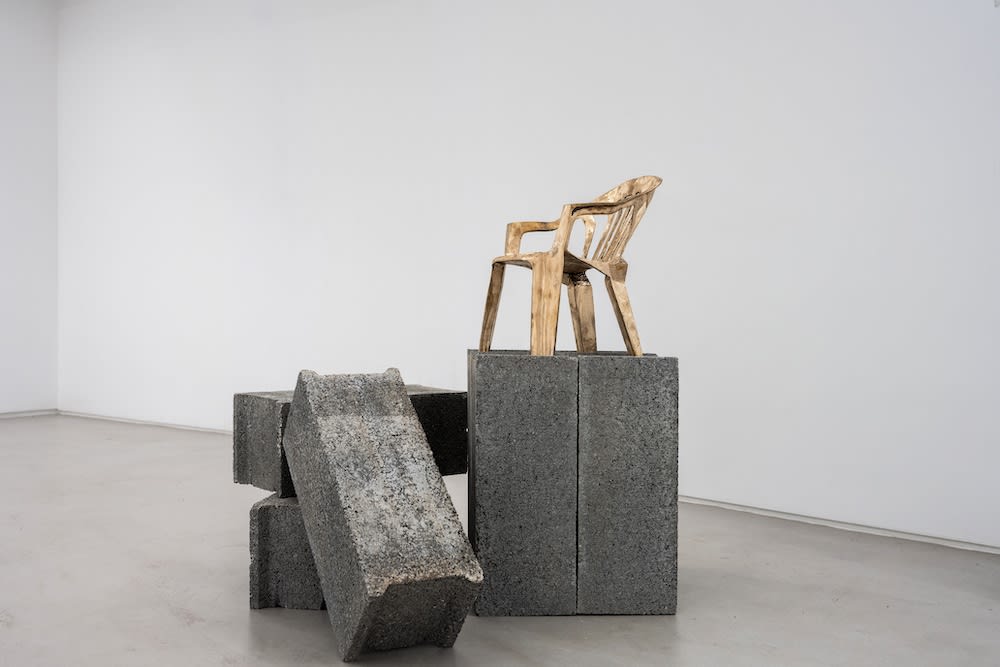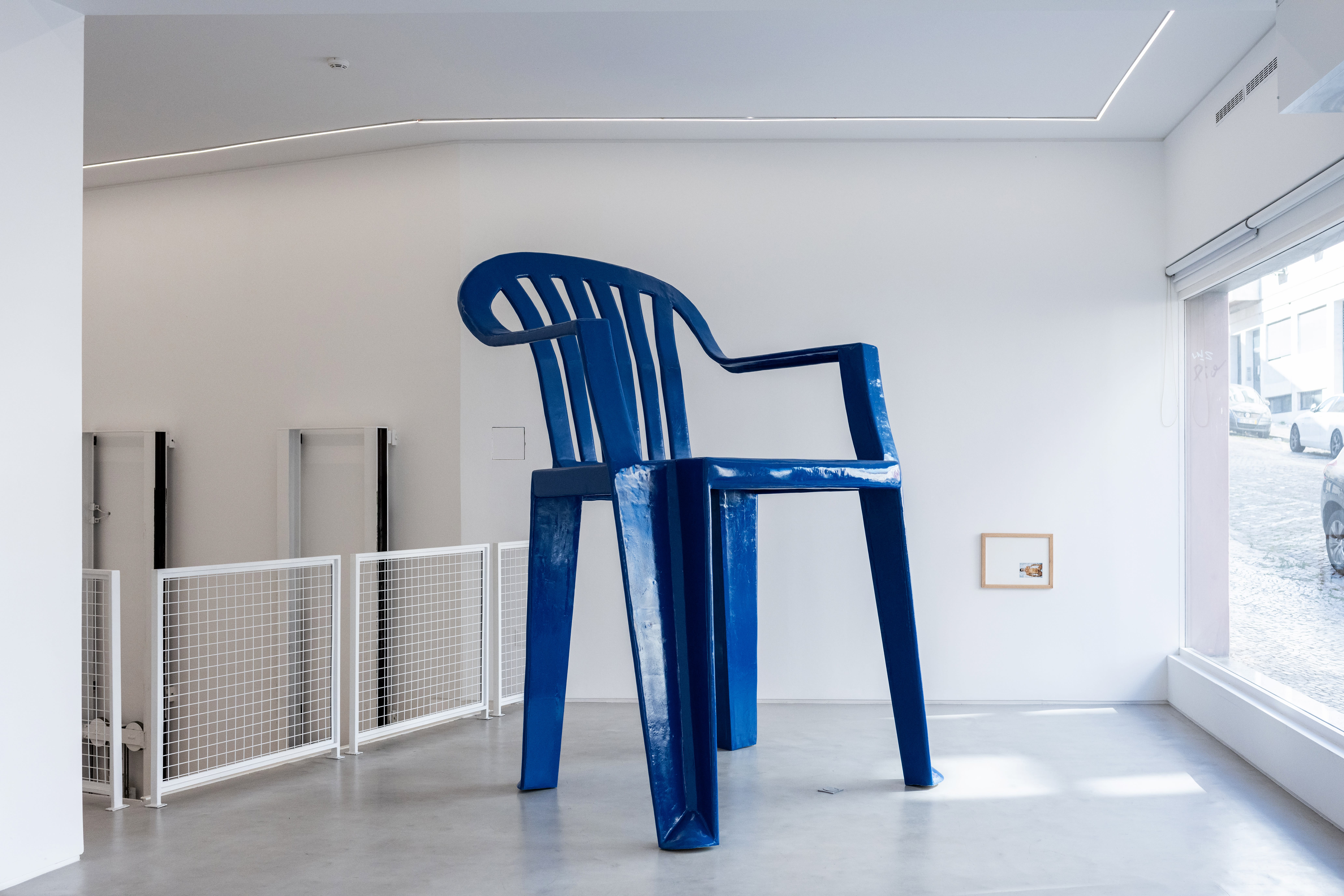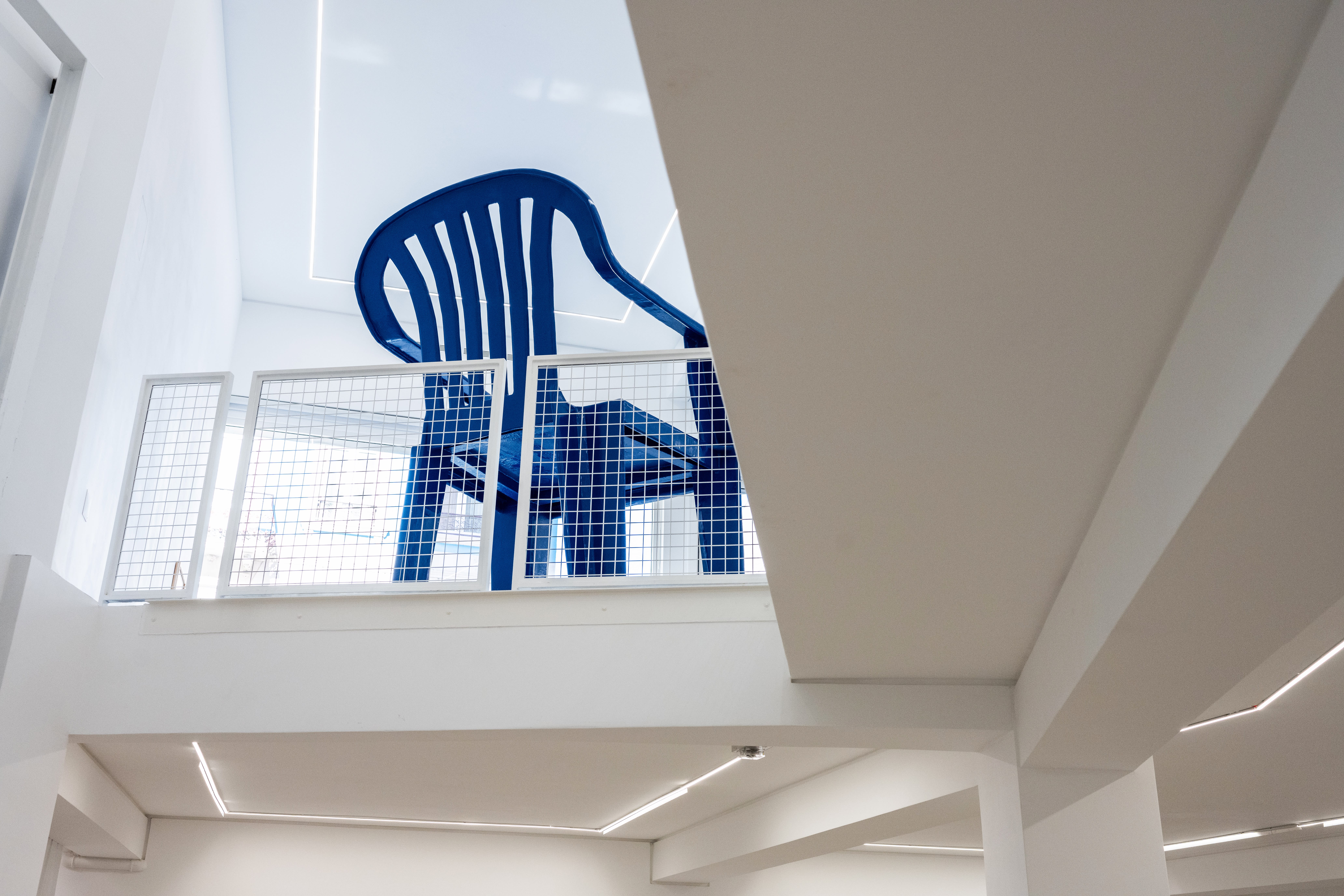
Kuril Chto is the pseudonym of the artist and resident at Voskhod Gallery. He has been based in Lisbon for several years and, working in various media, uses irony and absurdity to explore everyday life. Recently, the Foco Gallery, one of Lisbon's trendiest, hosted the exhibition "I'm curious blue" as part of the Novo Festival. We talked to Kuril Chto about the canvases, art objects and paintings on display. We also discussed his experiences studying at the New York Academy of Art and the differences between the American and European art markets.
The exhibition "I'm curious blue" recently came to an end in Lisbon, where you had presented a series of works on the plastic chair. How did you get involved with the theme of everyday objects?
I have been developing the theme of objects that shape our routine for around seven years now; for me, this is the poetry of everyday life. The chair is the hero of this series. As witnesses to our presence in the material world, chairs can tell us about ourselves, about our way of life, and about what we consider beautiful. In law school, I took a class on forensics. I was greatly impressed then by how criminologists collect, analyse, and interpret information from the surrounding objects at a crime scene. Unlike humans, objects are incapable of lying or distorting information, so I love working with them. They are like mute witnesses, not only to simple actions, but also to emotions, and moments that are often invisible at first glance. Developing this theme for the exhibition at Foсo Gallery, I made three bronze sculptures, a huge fibreglass chair, two paintings and two videos.

And what exactly is the message of the chairs in the exhibition?
For me, these chairs are about sadness, nostalgia and contemplation. People often put them in places where they like to relax, such as in a garden beneath the shade of bushes, in a picturesque place by the waterside, or in some other favourite personal place for contemplation. And yet, on its own, this object without a person is empty, as though speaking of a favourite place left behind or even an abandoned home. It's also as if this plastic chair were a symbol of our time. Being made of polymer plastic they don’t decompose, and are found on every continent. Thousands of years from now, scientists will really be able to judge the globality of our civilisation and the scale of modern production by these chairs.
How do the videos in the exhibition further explore this theme?
In the first video, I wanted to show the life of a chair in its natural habitat: in a field, on a beach, on a balcony, or in a car repair workshop. There are shots in it where I explore the body of the object. There are all kinds of monoblocks: they differ in shape, colour and proportions. I studied them a great deal, photographing them in different countries, in order to find the right shape. Focussing on this object for a long time, I began to notice plastic chairs all around me. As we know, by focussing on something, we are able to change our reality. I wanted to capture this phenomenon. And by the way, after the exhibition, many friends wrote to me about how they too were now noticing these chairs everywhere. They post photos and videos, and tag me.
The second video is a reflection on the transformation of a human being into an object. There are some professions that come with strict instructions which make a person resemble a robot. That of an air stewardess, for example. In my video, people turn into objects for a while – namely, into furniture.

How did you end up choosing this particular shape for the chair?
It seems quite naive and romantic to me, and that in itself is something that looks absurd in a plastic chair. The fan-shaped backrest seems to echo and play off classic Italian wooden chairs. The chair itself is very cheap and mass-produced, and striving in combination with this form looks quite ironic.
I was also interested in experimenting with scale and making an absurdly large object. Visitors were greeted by a chair that was two and a half metres high – taller than a human being. I liked the idea of making the chair monumental and totally devoid of any functionality. In front of it, a person might feel small, as though in a brief return to childhood – this opens people up for new experiences as they go further into the viewing process. It also touches in passing on the topical theme of dictatorships in the world today.

You painted this huge chair blue, and the exhibition as a whole is called "I'm curious blue". Why such an emphasis on that colour?
Blue is a calm, cool, fluid colour. It's a primary colour for me. It's about contemplation and accepting life as it is. Recently I was told of a legend where some elders stopped time by means of some magical blue light. That's what the colour blue means to me.
How does the Lisbon exhibition relate to the rest of your work today?
I've always strived to work with eternal themes such as beauty and love. But often I get distracted by terrible, unfair things that I can't help but react to. And I start talking about pain. But working with the heavy and painful themes of war, looting and acute injustice is absolutely exhausting and really burns you out. After such projects, it takes me another six months just to recover. And the latest exhibition in Lisbon is probably the first project I have worked on for pleasure’s sake alone, with it not being directly related to the war and events in Russia.

For many years now your home has been in Portugal, but in your art you do occasionally reflect on Russia. Do you consider yourself a Russian artist?
In my bio I write "Russian-born, Lisbon-based". But I think that art is a process of realisation that has no clear boundaries. In principle, I do not identify myself or other artists by nationality. Especially in today's globalised world, when artists often study in one country, then live in another, and then go somewhere else and travel around the world depending on their projects. The place where I was born just gives some colour to what I do. Of course, I do use the symbols I grew up with. But globally speaking I don't regard myself as a "Russian artist" or any other kind of artist; I'm just an artist.
Yes, a vast geography is definitely your story. A year ago you entered the New York Academy of Art. Why, as a fairly established artist with an impressive portfolio, did you decide to pursue this degree?
I started to feel that I couldn't always realise my ideas because I was lacking certain technical skills, so I decided to improve them. I enjoy studying academic drawing; I think it makes my work much more complex and more expressive.
Why did you choose New York rather than some European university?
New York is the capital of capitalism and the richest art market, with more collectors and therefore more opportunities in terms of sales than in Europe. More professionals, more gallery infrastructure – it’s interesting for me.

What has this experience given you so far?
I believe that every artist who has any ambitions towards an international career needs an international education. In the art world, networking is very important, especially in the US. And over the course of my studies I’ve got to know many local curators, gallerists and critics. This year I’ve already had several well-known artists and art professionals come to my studio, such as Jerry Saltz, the senior art historian and columnist for the New York magazine. I've been one of his subscribers for years, I love his jokes, and I just couldn't believe it when he came in and started commenting on my work. It only lasted ten minutes, but he pointed out some personal things so subtly and succinctly that I reflect on them to this day. I had a cookie in the studio and I saw him looking at it, so I sold him that cookie for five dollars and asked him to sign the receipt.
How exactly have studying in America and the new experience you have gained so far helped you to develop your creativity?
Being in America has changed and hardened me a lot. I’ve become much more efficient, for example. I have study intensively four days a week, from 10am to 9pm, and spend the rest of the time doing all sorts of homework. It's a lot of physical activity for me after the quiet of Portugal. It feels like I'm training for the drawing World Cup. At first it was really hard. But when I went back to Portugal in the summer holidays and was preparing a project for Foco Gallery, it felt like everything around me was in slow motion. Because there’s so much competition in America, you just get used to working on a different level and at a different pace.
Besides, New York is the main centre of painting now and the biggest contemporary art market on earth – about 40% of the world art market is concentrated here. So when you’re able to go to local exhibitions and see what other artists are doing, you start to realise what themes, materials and mediums can be made use of. For instance, in New York, I saw a trend for small bronze sculpture that is painted to match plastic and other cheaper materials. Expensive heavy timeless bronze mimicking other more perishable materials. And right when I was working on the chairs, I decided to try this technique. It looks really cool, and I plan to continue working with bronze in future.

What have you learned so far about the art scene in New York?
I was surprised at how the American audience is so closed-minded and not interested in what's going on in Europe. It's like I've come to another planet, where other topics are discussed. Painting is a big part of the market here. And in general, the American art market seems more conservative. Art prices here are insane, just like everything else. Studio rental, materials and assistant services cost a lot of money.
So it's easier to make a career as an artist in Europe than in America?
Yes, in Europe the entry point to art is much cheaper and more accessible. Many artists get grants. They don’t have to work other jobs, but can fully engage in creative endeavours while earning a living wage. However, the ceiling there is also much lower than in America.

What are your plans for the future, do you plan to stay in America?
I will go wherever I have projects; there is no strict plan, but it is important for me to continue developing and, of course, I see potential in the American market. When I finish my master’s, I hope to finally be able to concentrate on studio work. I want to create some big works and here I take my inspiration from Paul McCarthy and Jordan Wolfson. I've been to their shows here in New York and it's a wild delight!
What other artists are you inspired by?
I follow a lot of people. I'm impressed by Trey Abdella's painting skills. I like how Nadia Tolokonnikova is building her international career. My friends and very cool AES+F artists inspire me; I have a lot to learn from them in terms of international career, global vision and ideas. I regret having missed out on meeting Wassily Kandinsky. I love and often reread his book On the Spiritual in Art and would really have liked to communicate with him in person.
--------
Exhibition "I'm curious blue"
Kuril Chto x Rui Palma
Curated by: Josseline Black, Julian Pacomio, Benjamin Gonthier
FOCO gallery, Lisbon
06.07.2023-25.7.2023
